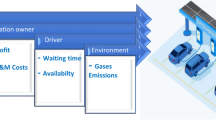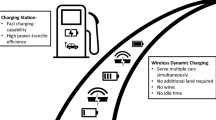Abstract
Emerging technologies play important roles in shaping future mobility systems and impacting sustainability performance of the transportation sector in major economies, such as the United States of America (USA) and China. This study applies a life cycle framework to demonstrate and evaluate the synergies of the following four emerging transportation system technologies both qualitatively and quantitatively: (1) wireless charging; (2) shared mobility services; (3) autonomous driving; and (4) battery electric vehicles (BEV). The new concept of a wireless charging and shared autonomous battery electric vehicle (W+SABEV) system is introduced and modeled. First, an analytical framework is presented to assess the pros and cons of the W+SABEV system vs. a conventional plug-in charging BEV system, adhering to the principles of sustainable mobility and highlighting the impacts and dynamics of the disruptive technologies on the key parameters that define sustainable mobility. Second, a quantitative analysis presents the synergies of the four technologies by modeling a W+SABEV system and demonstrates that the combination of the four technologies can shorten the payback time of greenhouse gas (GHG) emission burdens for infrastructure and vehicles. Compared to a plug-in charging BEV system, a W+SABEV system pays back the additional GHG emission burdens of wireless charging infrastructure deployment within 5 years if the wireless charging utility factor (ratio of en route charging time vs. trip time) is above 19%.




Similar content being viewed by others
References
Anastas PT, Zimmerman JB (2003) Design through the 12 principles of green engineering. Environ Sci Technol 37:94A–101A
Anderson JM, Nidhi K, Stanley KD, Sorensen P, Samaras C, Oluwatola OA (2014) Autonomous vehicle technology: A guide for policymakers. Rand Corporation, Santa Monica, California
Argonne National Laboratory (2017) The greenhouse gases, regulated emissions, and energy use in transportation (GREET) model. https://greet.es.anl.gov. Accessed May 2017
Bi Z, Song L, De Kleine R, Mi C, Keoleian GA (2015) Plug-in vs. wireless charging: life cycle energy and greenhouse gas emissions for an electric bus system. Appl Energy 146:11–19
Bi Z, Kan T, Mi CC, Zhang Y, Zhao Z, Keoleian GA (2016) A review of wireless power transfer for electric vehicles: prospects to enhance sustainable mobility. Appl Energy 179:413–425
BloombergNEF (2018) Electric vehicle outlook 2018. Bloomberg New Energy Finance (NEF), London
Chen TD, Kockelman KM, Hanna JP (2016) Operations of a shared, autonomous, electric vehicle fleet: implications of vehicle & charging infrastructure decisions. Transport Res A 94:243–254
Dzikiy P (2019) Oslo to become first city with wireless charging infrastructure for electric taxis. https://electrek.co/2019/03/21/oslo-wireless-charging-taxis/. Accessed April 2019
Fagnant DJ, Kockelman KM (2014) The travel and environmental implications of shared autonomous vehicles, using agent-based model scenarios. Transp Res C 40:1–13
Fulton L, Mason J, Meroux D (2017) Three revolutions in urban transportation: how to achieve the full potential of vehicle electrification, automation, and shared mobility in urban transportation systems around the world by 2050. No. STEPS-2050,
Gawron JH, Keoleian GA, De Kleine RD, Wallington TJ, Kim HC (2018) Life cycle assessment of connected and automated vehicles: sensing and computing subsystem and vehicle level effects. Environ Sci Technol 52:3249–3256
Hao H, Wang M, Zhou Y, Wang H, Ouyang M (2015) Levelized costs of conventional and battery electric vehicles in China: Beijing experiences. Mitig Adapt Strateg Glob Chang 20:1229–1246
Kan T, Nguyen T-D, White JC, Malhan RK, Mi C (2017) A new integration method for an electric vehicle wireless charging system using LCC compensation topology: analysis and design. IEEE Trans Power Electron 32:1–12
Kim HC, Wallington TJ, Arsenault R, Bae C, Ahn S, Lee J (2016) Cradle-to-gate emissions from a commercial electric vehicle Li-ion battery: a comparative analysis. Environ Sci Technol 50:7715–7722
Lee S, Choi B, Rim CT (2013) Dynamics characterization of the inductive power transfer system for online electric vehicles by Laplace phasor transform. IEEE Trans Power Electron 28:5902–5909
Li S, Mi C (2014) Wireless power transfer for electric vehicle applications. IEEE J Emerg Sel Topics Power Electron 3:4–17. https://doi.org/10.1109/JESTPE.2014.2319453
Lin Z, Li J, Dong J (2014) Dynamic wireless power transfer: potential impact on plug-in electric vehicle adoption SAE Technical Paper 2014-01-1965
Liu Z, Song Z (2017) Robust planning of dynamic wireless charging infrastructure for battery electric buses. Transp Res C 83:77–103
Plugless Power (2015) Plugless Power website. https://www.pluglesspower.com/. Accessed June 2015
Shoup D (2017) The high cost of free parking: Updated edition. Routledge, New York
Sperling D (2018) Three revolutions: steering automated, shared, and electric vehicles to a better future. Island Press, Washington D.C.
U.S. Department of Transportation (2017) National Household Travel Survey. https://nhts.ornl.gov/. Accessed January 2019
U.S. EPA (2016) Avoided emissions and generation tool (AVERT). U.S. Environmental Protection Agency (EPA) Office of Air and Radiation Climate Protection Partnerships Division, Washington D.C.
Zhou Y, Wang M, Hao H, Johnson L, Wang H (2015) Plug-in electric vehicle market penetration and incentives: a global review. Mitig Adapt Strateg Glob Chang 20:777–795
Zivin JSG, Kotchen MJ, Mansur ET (2014) Spatial and temporal heterogeneity of marginal emissions: implications for electric cars and other electricity-shifting policies. J Econ Behav Organ 107:248–268
Acknowledgements
This work is part of the U.S.-China Clean Energy Research Center (CERC) on Clean Vehicles. This work is supported by the U.S. Department of Energy, Argonne National Laboratory [award number 7F-30052] operated by UChicago Argonne LLC under Contract No. DE-AC02-06CH11357, and their industrial partners. This research also received support from a University of Michigan Rackham Graduate School PreDoctoral Fellowship. Dr. Yan Zhou, Dr. Michael Wang, and Dr. Zhenhong Lin’s research efforts are funded by the Vehicle Technologies Office of the U.S. Department of Energy Office of Energy Efficiency and Renewable Energy.
Author information
Authors and Affiliations
Corresponding author
Ethics declarations
Conflict of interest
The authors declare that they have no conflict of interest.
Additional information
Publisher’s note
Springer Nature remains neutral with regard to jurisdictional claims in published maps and institutional affiliations.
Zicheng Bi now work at Argonne National Laboratory (zbi@anl.gov)
Appendix
Appendix
This Appendix provides detailed model equations and calculations. To compare the system performance of the base case of a plug-in charging BEV fleet vs. a W+SABEV fleet, it is assumed that both systems will provide mobility services for a fixed total passenger travel per day, i.e., Φ = 12500 passengers per day, as shown in Eq. (1). Φ is a product of average number of passengers per trip (\( {\overline{n}}_{\mathrm{passenger}} \) for the base case and \( {{\overline{n}}^{\prime}}_{\mathrm{passenger}} \) for the W+SABEV), average number of trips per vehicle per day (\( {\overline{n}}_{\mathrm{trip}} \) for the base case and \( {{\overline{n}}^{\prime}}_{\mathrm{trip}} \) for the W+SABEV), and number of vehicles (nveh for the base case and \( {n}_{\mathrm{veh}}^{\prime } \) for the W+SABEV). The average mileage per vehicle per day (\( \overline{L} \) for the base case and \( {\overline{L}}^{\prime } \) for the W+SABEV) can be calculated using Eq. (2) to Eq. (5) with the average miles per trip (\( {\overline{d}}_{\mathrm{trip}} \) = 10 miles/trip), miles of detour per passenger (\( {\overline{d}}_{\mathrm{passenger}} \) = 1 mile/passenger), smart routing (eco-driving) factor θ, range extension factor β, and ridership factor κ.
The average BEV battery capacity for the base case cB is defined by Eq. (6), where e is the average energy consumption rate of a battery electric vehicle (0.33 kWh/mile) and ε is the state of charge window (60%), i.e., the operating capacity relative to the nameplate capacity. The autonomous driving device consumes additional energy eAV(kWh/mile), which is assumed to be a proportion (μ = 10%) of e, as shown in Eq. (7). The time of en route charging \( {\overline{T}}_{\mathrm{SWPT}} \) (hours of charging per vehicle per day) at SWPT charging spots can be calculated by multiplying the utility factor kSWPT (probability of encountering a SWPT charging spot), number of stops at traffic intersections per day \( \frac{{\overline{L}}^{\prime }}{{\overline{d}}_{\mathrm{stop}}} \) (where \( {\overline{d}}_{\mathrm{stop}} \) is the average distance between stops), and average stoppage time at a traffic intersection (\( {\overline{t}}_{\mathrm{SWPT}} \)), as shown in Eq. (8). Similarly, the time of en route charging \( {\overline{T}}_{\mathrm{DWPT}} \) (hours of charging per vehicle per day) on DWPT charging lanes can be calculated by multiplying the utility factor kDWPT (probability of driving on a DWPT lane) and total vehicle operating time per day \( \frac{{\overline{L}}^{\prime }}{\overline{v}} \) (where \( \overline{v} \) is average vehicle speed), as shown in Eq. (9). The average battery capacity for a vehicle in the W+SABEV fleet \( {c}_{\mathrm{B}}^{{\prime\prime} } \) can be calculated using Eq. (10) to Eq. (13). The base case battery capacity cB needs to be adjusted by taking into account the following factors: (1) those en route charging (\( {\eta}_{\mathrm{SWPT}}{\eta}_{\mathrm{B}}P{\overline{T}}_{\mathrm{SWPT}} \) and \( {\eta}_{\mathrm{DWPT}}{\eta}_{\mathrm{B}}P{\overline{T}}_{\mathrm{DWPT}} \)) can downsize the battery; (2) vehicle weight change resulting from battery weight change, equipment weight change, and passengers’ weight change; and (3) energy consumption rate change due to vehicle weight change, smart driving, and additional energy consumption by autonomous driving device. ηSWPT is the SWPT grid-to-battery charging efficiency, ηB is the battery charge/discharge efficiency (90%), P is the actual power rate (30 kW), ηDWPT is the grid-to-battery DWPT charging efficiency, cB, min is the assumed minimum battery capacity (20 kWh), ρ is 0.156 kWh/kg of lithium ion battery of a Tesla Model S, \( {\overline{\varDelta}}_e \) is the average change in energy consumption rate (kWh/mile),wperson is the average weight of a person (79 kg),wOW is the weight of an onboard wireless charger (16 kg), wAV is the weight of autonomous driving device (16–22 kg) (Gawron et al. 2018),wveh is the weight of a base case vehicle (1595 kg), ϕ is the lightweighting correlation (6% energy consumption reduction per 10% vehicle weight reduction) (Bi et al. 2015), λ is a factor characterizing the energy saving due to smart routing (eco-driving) and better speed control of autonomous vehicles and is assumed to equal θ, e′ is the energy consumption rate (kWh/mile) for a W+SABEV, \( {c}_{\mathrm{B}}^{\prime } \) is the intermediate calculated battery capacity for a W+SABEV, and \( {c}_{\mathrm{B}}^{{\prime\prime} } \) is the final calculated battery capacity of a W+SABEV.
Finally, the breakeven time τ (days) is calculated by letting fnet = fburdens − fsavings = 0 and solving Eq. (14) to Eq. (19). fnet,fburdens, and fsavings are the cumulative net emissions (kg CO2-eq), additional burdens of W+SABEV infrastructure and device (kg CO2-eq), and additional savings of W+SABEV (kg CO2-eq), respectively.nSWPT is number of traffic intersections with SWPT and ζDWPT is the total mileage of DWPT lanes. σSWPT, base (453 kg CO2-eq), σDWPT, base (1,184,000 kg CO2-eq/lane-mile), and σOW, base (103 kg CO2-eq) are the burdens of a 6 kW (Pbase) wireless charger (Bi et al. 2015) and σAV (1300 kg CO2-eq) is the burden of an autonomous vehicle device (Gawron et al. 2018). \( \overline{l} \) is the actual average length of SWPT at a traffic intersection and lbase is the base length (10 m). sV is the savings from fleet size reduction (kg CO2-eq), sB is the battery savings (kg CO2-eq), and sE is the electricity savings (kg CO2-eq). σveh is the vehicle production and manufacturing burden without battery (7000 kg CO2-eq) (Kim et al. 2016) and σB is the battery production and manufacturing burden (32.64 kg CO2-eq/kWh) (Bi et al. 2015). ηPC is the plug-in charging efficiency from grid-to-battery (90%). \( {\overline{\sigma}}_{\mathrm{E},\mathrm{night}} \) and \( {\overline{\sigma}}_{\mathrm{E},\mathrm{day}} \) are average nighttime and daytime electricity emission intensities (kg CO2-eq/kWh), respectively (U.S. EPA 2016).
Rights and permissions
About this article
Cite this article
Bi, Z., Reiner, M.A., Keoleian, G.A. et al. Wireless charging and shared autonomous battery electric vehicles (W+SABEV): synergies that accelerate sustainable mobility and greenhouse gas emission reduction. Mitig Adapt Strateg Glob Change 25, 397–411 (2020). https://doi.org/10.1007/s11027-019-09870-9
Received:
Accepted:
Published:
Issue Date:
DOI: https://doi.org/10.1007/s11027-019-09870-9




